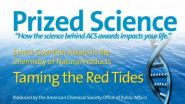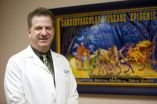(Press-News.org) BOSTON (11-22-10) -- Boston University researchers have developed a simple diagnostic tool that can quickly identify dangerous viruses like Ebola and Marburg. The biosensor, which is the size of a quarter and can detect viruses in a blood sample, could be used in developing nations, airports and other places where natural or man-made outbreaks could erupt.
"By enabling ultra-portable and fast detection, our technology can directly impact the course of our reaction against bio-terrorism threats and dramatically improve our capability to confine viral outbreaks," said Assistant Professor Hatice Altug of the Boston University College of Engineering, who co-led the research team with Assistant Professor John Connor of the Boston University School of Medicine.
Traditional virus diagnostic tools are effective, but require significant infrastructure and sample preparation time. The new biosensor developed at Boston University directly detects live viruses from biological media with little to no sample preparation. The breakthrough is detailed in the Nov. 5 online edition of Nano Letters.
From bird flu to H1N1, outbreaks of fast-spreading viral diseases in recent years have sparked concern of pandemics similar to the 1918 Spanish Flu that caused more than 50 million deaths. A significant fraction of today's viral threats are viruses that use RNA to replicate. Individuals infected with these viruses often show symptoms that are not virus-specific, making them difficult to diagnose. Among them are hemorrhagic fever viruses, such as Ebola and Marburg, which could be used as bio-warfare agents. Critical to identifying and containing future epidemics of RNA-based viruses is the development of rapid, sensitive diagnostic techniques that healthcare providers can quickly deploy so that infected individuals can be quickly identified and treated.
Partly funded through the Boston University Photonics Center and the U.S. Army Research Laboratory, and working in collaboration with the U.S. Army Medical Research Institute for Infectious Diseases, the team has demonstrated reliable detection of hemorrhagic fever virus surrogates (i.e. for the Ebola virus) and pox viruses (such as monkeypox or smallpox) in ordinary biological laboratory settings.
"Our platform can be easily adapted for point-of-care diagnostics to detect a broad range of viral pathogens in resource-limited clinical settings at the far corners of the world, in defense and homeland security applications as well as in civilian settings such as airports," said Altug.
Connor noted an additional, significant advantage of the new technology. "It will be relatively easy to develop a diagnostic device that simultaneously tests for several different viruses," he observed. "This could be extremely helpful in providing the proper diagnosis."
The new biosensor is the first to detect intact viruses by exploiting plasmonic nanohole arrays, or arrays of apertures with diameters of about 200 to 350 nanometers on metallic films that transmit light more strongly at certain wavelengths. When a live virus in a sample solution, such as blood or serum, binds to the sensor surface, the refractive index in the close vicinity of the sensor changes, causing a detectable shift in the resonance frequency of the light transmitted through the nanoholes. The magnitude of that shift reveals the presence and concentration of the virus in the solution.
"Unlike PCR and ELISA approaches, our method does not require enzymatic amplification of a signal or fluorescent tagging of a product, so samples can be read immediately following pathogen binding," said Altug. Ahmet Yanik, Altug's research associate who conducted the experiments, added, "Our platform can detect not only the presence of the intact viruses in the analyzed samples, but also indicate the intensity of the infection process."
The researchers are now working on a highly portable version of their biosensor platform using microfluidic technology designed for use in the field with minimal training.
### END
New tool detects Ebola, Marburg quickly, easily
Boston University researchers develop portable diagnostic device
2010-11-23
ELSE PRESS RELEASES FROM THIS DATE:
Ultrathin alternative to silicon for future electronics
2010-11-23
There's good news in the search for the next generation of semiconductors. Researchers with the U.S. Department of Energy's Lawrence Berkeley National Laboratory (Berkeley Lab) and the University of California (UC) Berkeley, have successfully integrated ultra-thin layers of the semiconductor indium arsenide onto a silicon substrate to create a nanoscale transistor with excellent electronic properties. A member of the III–V family of semiconductors, indium arsenide offers several advantages as an alternative to silicon including superior electron mobility and velocity, ...
Hybrid tugboat cuts emissions, University of California, Riverside study shows
2010-11-23
RIVERSIDE, Calif. (www.ucr.edu) --A new study by University of California, Riverside scientists of what is believed to be the world's only hybrid electric tugboat found that the vessel is effective in reducing emissions at the Ports of Los Angeles and Long Beach.
Researchers at the UC Riverside College of Engineering Center for Environmental Research and Technology (CE-CERT) demonstrated the hybrid electric tugboat reduces emissions of soot by about 73 percent, oxides of nitrogen (which help cause smog) by 51 percent, and carbon dioxide, which contributes to global warming, ...
Overweight primarily a problem among wealthier women in low- to middle-income countries
2010-11-23
Boston, MA – A new study from the Harvard School of Public Health (HSPH) finds that high body mass index (BMI) in developing countries remains primarily a problem of the rich. The findings suggest that the shift towards overweight and obesity among the poor that has already happened in wealthier countries has not yet happened in developing countries.
The study appears in an advance online edition of the American Journal of Clinical Nutrition and will appear in an upcoming print edition.
"Previous research on the increasing overweight and obesity burden in developing countries ...
Mayo Clinic study finds aggressive surgery is best for children with brain tumors
2010-11-23
ROCHESTER, Minn. -- A new Mayo Clinic study (http://newsblog.mayoclinic.org/2008/12/03/brain-tumors-best-treatments-for-long-term-survival/) found that children with low-grade brain tumors (gliomas) (http://www.mayoclinic.org/brain-tumors/) who undergo aggressive surgery to completely remove the tumor have an increased chance of overall survival. If complete removal is not possible, adding radiation therapy to a less complete surgery provides patients with the same outcomes as a complete removal. This study was presented at the Society for NeuroOncology Annual Scientific ...
New American Chemical Society Prized Science video focuses on shrinking the computer chip
2010-11-23
WASHINGTON, Nov. 22, 2010 — The science that helped make today's smartphones and iPods smaller but more powerful than yesterday's desktop computers highlights the latest episode in the American Chemical Society (ACS) Prized Science video series.
The new high-definition video, released today, focuses on IBM chemist Robert Miller, winner of the 2010 ACS Award for Chemistry of Materials. Miller developed materials that helped pack more transistors onto each computer chip, those postage stamp-size slivers of silicon that make up the brains of computers and other electronic ...
University of Minnesota engineering researcher finds new way to fight antibiotic-resistant bacteria
2010-11-23
New findings by civil engineering researchers in the University of Minnesota's College of Science and Engineering shows that treating municipal wastewater solids at higher temperatures may be an effective tool in the fight against antibiotic-resistant bacteria.
Heating the solid waste to 130 degrees Fahrenheit (55 degrees Celsius) was particularly effective in eliminating the genes that confer antibiotic resistance. These genes are used by bacteria to become resistant to multiple antibiotics, which are then known as "superbacteria" or "superbugs."
The research paper ...
The not-so-sweet truth about sugar -- a risk choice?
2010-11-23
More and more people have become aware of the dangers of excessive fructose in diet. A new review on fructose in an upcoming issue of the Journal of the American Society of Nephrology (JASN) indicates just how dangerous this simple sugar may be.
Richard J. Johnson, MD and Takahiko Nakagawa, MD (Division of Renal Diseases and Hypertension, University of Colorado) provide a concise overview of recent clinical and experimental studies to understand how excessive amounts of fructose, present in added sugars, may play a role in high blood pressure, diabetes, obesity, and ...
Perceptual training improves vision of the elderly
2010-11-23
RIVERSIDE, Calif. – Elderly adults can improve their vision with perceptual training, according to a study from the University of California, Riverside and Boston University that has implications for the health and mobility of senior citizens.
The study, "Perceptual learning, aging, and improved visual performance in early stages of visual processing," appears in the current online issue of the Journal of Vision. It was funded by a $3.5 million grant from the National Institute on Aging.
UCR researchers G. John Andersen, professor of psychology; Rui Ni, formerly a postdoctoral ...
HIV drugs interfere with blood sugar, lead to insulin resistance
2010-11-23
The same powerful drugs that have extended the lives of countless people with HIV come with a price – insulin resistance that can lead to diabetes and cardiovascular disease.
Now, researchers at Washington University School of Medicine in St. Louis have determined why that happens. Their research shows that HIV protease inhibitors directly interfere with the way blood sugar levels are controlled in the body. This leads to insulin resistance, a condition that occurs when the body produces enough insulin but doesn't use it properly.
This confirmation provides the potential ...
Number of doctorates awarded continued to grow in 2009
2010-11-23
U.S. academic institutions awarded 49,562 research doctorate degrees in 2009, the highest number ever reported by the National Science Foundation's Survey of Earned Doctorates (SED), and a 1.6 percent increase over 2008's total of 48,802.
The SED is an annual census of all individuals who receive a research doctorate from a U.S. academic institution in an academic year, which is July 1 through June 30 of the following year. The 2009 census covered individuals who earned doctorates in the academic year ending June 2009. NSF's Science Resources Statistics division compiled ...
LAST 30 PRESS RELEASES:
American Meteorological Society announces new executive director
People with “binge-watching addiction” are more likely to be lonely
Wild potato follows a path to domestication in the American Southwest
General climate advocacy ad campaign received more public engagement compared to more-tailored ad campaign promoting sustainable fashion
Medical LLMs may show real-world potential in identifying individuals with major depressive disorder using WhatsApp voice note recordings
Early translational study supports the role of high-dose inhaled nitric oxide as a potential antimicrobial therapy
AI can predict preemies’ path, Stanford Medicine-led study shows
A wild potato that changed the story of agriculture in the American Southwest
Cancer’s super-enhancers may set the map for DNA breaks and repair: A key clue to why tumors become aggressive and genetically unstable
Prehistoric tool made from elephant bone is the oldest discovered in Europe
Mineralized dental plaque from the Iron Age provides insight into the diet of the Scythians
Salty facts: takeaways have more salt than labels claim
When scientists build nanoscale architecture to solve textile and pharmaceutical industry challenges
Massive cloud with metallic winds discovered orbiting mystery object
Old diseases return as settlement pushes into the Amazon rainforest
Takeaways are used to reward and console – study
Velocity gradients key to explaining large-scale magnetic field structure
Bird retinas function without oxygen – solving a centuries-old biological mystery
Pregnancy- and abortion-related mortality in the US, 2018-2021
Global burden of violence against transgender and gender-diverse adults
Generative AI use and depressive symptoms among US adults
Antibiotic therapy for uncomplicated acute appendicitis
Childhood ADHD linked to midlife physical health problems
Patients struggle to measure blood pressure at home
A new method to unlock vast lithium stores
Scientists unveil “dissolution barocaloric” cooling, opening new path to zero-carbon refrigeration
Microplastics in the atmosphere: Higher emissions from land areas than from the ocean
Metal clumps in quantum state: Vienna research team breaks records
PolyU develops new human-safe magnetorheological fibres, leading innovations in smart wearable textiles
Rice establishes Global Brain Economy Initiative in Davos, aligned with new report on brain health and AI
[Press-News.org] New tool detects Ebola, Marburg quickly, easilyBoston University researchers develop portable diagnostic device

